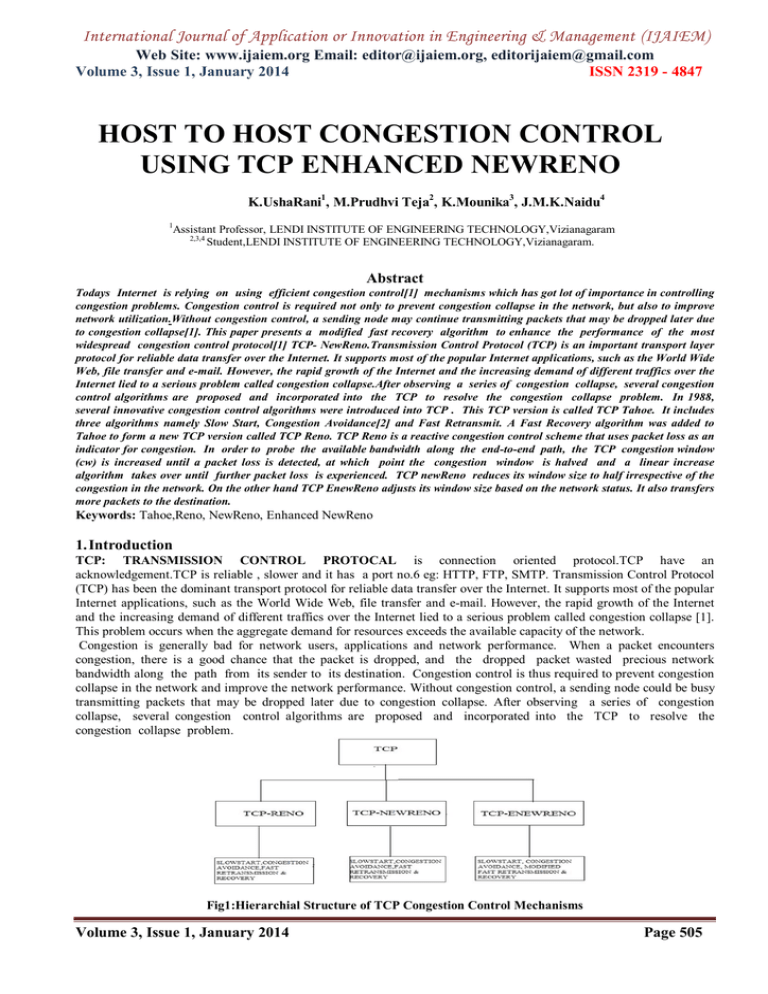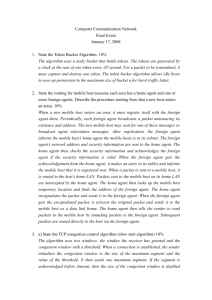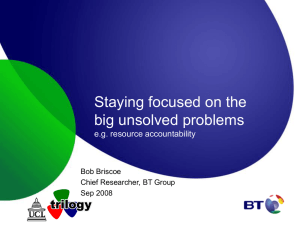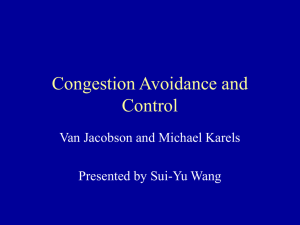HOST TO HOST CONGESTION CONTROL USING TCP ENHANCED NEWRENO
advertisement

International Journal of Application or Innovation in Engineering & Management (IJAIEM)
Web Site: www.ijaiem.org Email: editor@ijaiem.org, editorijaiem@gmail.com
Volume 3, Issue 1, January 2014
ISSN 2319 - 4847
HOST TO HOST CONGESTION CONTROL
USING TCP ENHANCED NEWRENO
K.UshaRani1, M.Prudhvi Teja2, K.Mounika3, J.M.K.Naidu4
1
Assistant Professor, LENDI INSTITUTE OF ENGINEERING TECHNOLOGY,Vizianagaram
2,3,4
Student,LENDI INSTITUTE OF ENGINEERING TECHNOLOGY,Vizianagaram.
Abstract
Todays Internet is relying on using efficient congestion control[1] mechanisms which has got lot of importance in controlling
congestion problems. Congestion control is required not only to prevent congestion collapse in the network, but also to improve
network utilization.Without congestion control, a sending node may continue transmitting packets that may be dropped later due
to congestion collapse[1]. This paper presents a modified fast recovery algorithm to enhance the performance of the most
widespread congestion control protocol[1] TCP- NewReno.Transmission Control Protocol (TCP) is an important transport layer
protocol for reliable data transfer over the Internet. It supports most of the popular Internet applications, such as the World Wide
Web, file transfer and e-mail. However, the rapid growth of the Internet and the increasing demand of different traffics over the
Internet lied to a serious problem called congestion collapse.After observing a series of congestion collapse, several congestion
control algorithms are proposed and incorporated into the TCP to resolve the congestion collapse problem. In 1988,
several innovative congestion control algorithms were introduced into TCP . This TCP version is called TCP Tahoe. It includes
three algorithms namely Slow Start, Congestion Avoidance[2] and Fast Retransmit. A Fast Recovery algorithm was added to
Tahoe to form a new TCP version called TCP Reno. TCP Reno is a reactive congestion control scheme that uses packet loss as an
indicator for congestion. In order to probe the available bandwidth along the end-to-end path, the TCP congestion window
(cw) is increased until a packet loss is detected, at which point the congestion window is halved and a linear increase
algorithm takes over until further packet loss is experienced. TCP newReno reduces its window size to half irrespective of the
congestion in the network. On the other hand TCP EnewReno adjusts its window size based on the network status. It also transfers
more packets to the destination.
Keywords: Tahoe,Reno, NewReno, Enhanced NewReno
1. Introduction
TCP: TRANSMISSION CONTROL PROTOCAL is connection oriented protocol.TCP have an
acknowledgement.TCP is reliable , slower and it has a port no.6 eg: HTTP, FTP, SMTP. Transmission Control Protocol
(TCP) has been the dominant transport protocol for reliable data transfer over the Internet. It supports most of the popular
Internet applications, such as the World Wide Web, file transfer and e-mail. However, the rapid growth of the Internet
and the increasing demand of different traffics over the Internet lied to a serious problem called congestion collapse [1].
This problem occurs when the aggregate demand for resources exceeds the available capacity of the network.
Congestion is generally bad for network users, applications and network performance. When a packet encounters
congestion, there is a good chance that the packet is dropped, and the dropped packet wasted precious network
bandwidth along the path from its sender to its destination. Congestion control is thus required to prevent congestion
collapse in the network and improve the network performance. Without congestion control, a sending node could be busy
transmitting packets that may be dropped later due to congestion collapse. After observing a series of congestion
collapse, several congestion control algorithms are proposed and incorporated into the TCP to resolve the
congestion collapse problem.
Fig1:Hierarchial Structure of TCP Congestion Control Mechanisms
Volume 3, Issue 1, January 2014
Page 505
International Journal of Application or Innovation in Engineering & Management (IJAIEM)
Web Site: www.ijaiem.org Email: editor@ijaiem.org, editorijaiem@gmail.com
Volume 3, Issue 1, January 2014
ISSN 2319 - 4847
1.1 Tahoe:In 1988, several innovative congestion control algorithms were introduced into TCP . This TCP version is
called TCP Tahoe[3]. It includes three algorithms namely Slow Start, Congestion Avoidance and Fast Retransmit[4].
1.2 TCP Reno:Two years later, a Fast Recovery algorithm was added to Tahoe to form a new TCP version called TCP
Reno[3]. TCP Reno is a reactive congestion control scheme that uses packet loss as an indicator for congestion. In
order to probe the available bandwidth along the end-to-end path, the TCP congestion window (cw) is increased
until a packet loss is detected, at which point the congestion window is halved and a linear increase algorithm
takes over until further packet loss is experienced.
Generally, the congestion window is used to limit the amount of data that the sender can inject into the network in
order to prevent the source from overrunning the capacity of the network. In Reno, the TCP sender changes its congestion
window size according to the congestion control algorithms; Slow-Start, Congestion Avoidance, Fast Retransmit
and Fast Recovery . In , the authors have shown that the TCP Reno may periodically generate packet loss by itself
and cannot efficiently recover multiple packet losses from a window of data. Moreover, the Additive Increase and
Multiplicative Decrease (AIMD) strategy of TCP Reno leads to periodic oscillations in the aspects of the congestion
window size, round-trip delay, and queue length of the bottleneck node. Indeed, the oscillation may induce
chaotic behavior in the network, thereby adversely affecting overall network performance.
1.3 TCP NewReno: To alleviate the performance degradation problem of packet loss, many researchers attempted to
refine the Fast Retransmit and the Fast Recovery algorithms of the TCP Reno . In , a congestion control mechanism,
called TCP NewReno, is developed using an augmented Fast Recovery algorithm to overcome the problem of TCP Reno
and combat multiple packet losses from the same transmission window without entering into Fast Recovery multiple
times. That is, TCP New Reno modifies the sender behaviour during Fast Recovery algorithm, where, it continues in Fast
Recovery until all the packets which were outstanding during the start of the Fast Recovery have been acknowledged.
Although the additional modifications to the Fast Recovery algorithm improve the performance of TCP NewReno, it has
been found that the TCP NewReno is inefficient in terms of utilization of link capacity and unfair in throughput .
The problem with NewReno is that, within Fast Recovery algorithm, it halves its congestion window irrespective of the
state of the network as long as a packet loss is detected.
/* After fast retransmit; do not enter slow start */ Recovery phase:
cw = sst + 3; sst = cw / 2;
Received Each DACK;
cw=cw+1;
After receiving an Ack:
if allow Send new packet ;
If partial Ack;
Stay in fast recovery;
Retransmit next lost packet(one packet per ReTT);
If Full Ack; cw = sst;
Quit fast recovery;
Evoke Congestion Avoidance Phase;
When Timeout:
sst = cw /2;
cw = 1;
Evoke Slow Start Phase;
Another problem arises with NewReno is that when there are no packet losses, but packets are reordered by more than
three duplicate acknowledgments; NewReno mistakenly enters Fast Recovery, and halves its congestion window .
TCP Enhanced NewReno: This work presents a modified Fast Recovery algorithm to improve the TCP-NewReno[6]
performance. The basic idea is to adjust the congestion window (cw) of the TCP sender based on the level of congestion
in the network so as to allow transferring more packets to the destination. The proposed mechanism, called
Enhanced NewReno (EnewReno). The proposed mechanism improves the performance of the TCP-NewReno against
throughput and packet delay.
TCP NEW RENO
1. NewReno is inefficient in terms of
utilization of link capacity and unfair in
throughput.
2. Halves
its
congestion window
irrespective of The state of the network.
3.Packet reordering occurs when there is a
Volume 3, Issue 1, January 2014
TCP ENHANCED NEW RENO
1. ENewReno is efficient in terms of
utilization of link capacity and unfair in
throughput.
2. Halves its congestion window with
respective to the state of the network.
3. Packet reordering occurs when there is a
Page 506
International Journal of Application or Innovation in Engineering & Management (IJAIEM)
Web Site: www.ijaiem.org Email: editor@ijaiem.org, editorijaiem@gmail.com
Volume 3, Issue 1, January 2014
ISSN 2319 - 4847
even no packet loss by receiving more than packet loss by receiving more than three
three duplicate acknowledgments.
duplicate acknowledgments.
4.No reduction of Congestion window but
4. Congestion window is reduced when
sets to half of the current size.
packet is occured.
5. Data Transmission rate is moderate.
5. Data Transmission rate is high.
1.5 APPLICATIONS
1.Virtual private network(To find information)
2.Rexec (Remote Execution Server)protocol that enables a client user to submit system commands to a remote
system)
3.Talk protocol
2.TECHNIQUES
The EnewReno is formed by using the main three algorithms; Slow Start, Congestion Avoidance[2], and Fast
Retransmit, in addition to the modified Fast Recovery algorithm.
2.1 SLOW START AND CONGESTION AVOIDANCE PHASE:
Initially, the congestion window(cw) size is taken as one and increases linearly for each acknowledgement from
receiver and continues till slow start thresh (sst) is reached.
Initial: cw = 1;
For (Acked of each packet)
Cw=cw+1;
Until ( cw> sst)
After sst, the packet enters into congestion avoidance phase to slow the increasing rate of the cwnd.In this phase, the
window size increases linearly by one segment for every round trip time(RTT) as long as congestion is detected in the
network.At this point,to resolve the network congestion the transmission rate is reduced.
/* cw > sst and slow start is finished */
Each Ack:
cw = cw + (1/cw)
Until (3 DUPACKs or Timeout )
2.2 FAST RETRANSMISSION
During Congestion Avoidance,the nework congestion is signaled by the reception of 3 duplicate acknowledgements[7] or
by retransmission time out(RTO).If the congestion is indicated by timeout, sender enters into slow start again. If
congestion is indicated by duplicate acknowlegdements[7], the sender goes into the fast retransmit[4] mode to retransmit
the lost packets[10].
/* After receiving 3 DUPACKs */
Again send lost packet;
Evoke Fast Recovery Phase
2.3 MODIFIED FAST RECOVERY
After the packet loss is occured,the packet is entered into fast recovery phase[5] to reduce those losses of packets to give
maximum throughput[8] and also reduces the packet delay.
/* After fast retransmit; do not enter slow start */
cw = max {2, (cw − Avgnum)};
Avgno =cw/ReTTavg*(∆-ReTT)
sst = max {2, cw};
cw= sst + 3;
Each DACK received;
Cw=cw+1;
If allow Send new packet;
After partial Ack;
Stay in fast recovery;
Again transmit next lost packet (per each ReTT);
After Full Ack:
cw = sst;
Quit Fast Recovery;
Evoke Congestion Avoidance Phase;
ii-When TimeOut:
cw = max {2, (cw − Avgnum)};
sst = max {2, cwndn};
cw = 1;
Volume 3, Issue 1, January 2014
Page 507
International Journal of Application or Innovation in Engineering & Management (IJAIEM)
Web Site: www.ijaiem.org Email: editor@ijaiem.org, editorijaiem@gmail.com
Volume 3, Issue 1, January 2014
ISSN 2319 - 4847
Evoke Slow Start Phase;
3. METHODOLOGIES
3.1 ARCHITECTURE
In slowstart phase initially window size will be taken as 1. When each packet ack received congestion will be increased
until the congestion event occur or cw>sst.After it will be entered in to congestion avoidance phase, in this cw>sst.When
every ack occur cw will be equals to the sum of cw and inverse of cw until the time out occur or 3dup ack occured.After
this, retransmit phase will be occurred when 3 dup Acks are received it shows packet loss so resend the lost packet.After
it enter in to the fast recovery phase,initially cw will be taken as max[2,(cw-AVGnum)], AVGnum means that (Ratio of
the cw and ReTTavg)*(ReTT1-ReTT2) value and sst value will be taken as max{2,cw} and cw=sst+3.
When each DACK will be recived then cw will be increased.If it allow new packet will be send.In this we have occurred
two types of acks. 1:partial ack and 2:full ack.If partial ack will be occur then stay in fast recovery phase and retransmit
the lost packet.If full ack will be occur then cw=sst and exit from fast recovery phase.After that enters in to congestion
avoidance phase.When time out occured then cw=max[2,(cw-AVGnum)] and sst=max{2,cw}.Afer, window size will be
taken as 1 now it again goes to initial phase i.e slow start phase.This process will be repeated.
3.2 GRAPHS
Volume 3, Issue 1, January 2014
Page 508
International Journal of Application or Innovation in Engineering & Management (IJAIEM)
Web Site: www.ijaiem.org Email: editor@ijaiem.org, editorijaiem@gmail.com
Volume 3, Issue 1, January 2014
ISSN 2319 - 4847
3.3 DESCRIPTION
In slow start phase, the cw size is initially taken as one and goes on increasing till sst is reached. The point at which the
packet enters sst+1 becomes the congestion avoidance phase. in this phase, if time out occurs or 3 duplicate ACK’s occur
indicates that the packet is lost.
After the avoidance phase enter into fast retransmit phase to resend the lost packets. After this phase, reduce the cw by
half and continue sending segments at this reduced level. By doing this, the sender has too many outstanding packets
and has no knowledge of how to send the packets in case duplicate acknowledgements are received
4. CONCLUSION
In this work a modified Fast Recovery algorithm, ENewReno is proposed to improve the performance of the TCP
NewReno. The mechanism is developed by adapting the congestion window of the TCP sender based on the level of
congestion in the network. This level is determined by using the Round Trip Time (RTT) that represents as an indicator
for the traffic loads on the network. Incorporating the modified Fast Recovery algorithm[9] with the TCP NewReno
improves its performance against both the throughput and the packet delay because of transferring more packets to the
destination. Although the additional modifications to the Fast Recovery algorithm improve the performance of the
proposed mechanism, Additional enhancements should be considered in the future work to improve the EnewReno
against performance.
REFERENCES
[1.] J. Nagle, “Congestion control in IP/TCP Internetworks,” Request for Comments (RFC) 896, Internet Engineering
Task Force, January 1984.
[2.] Jacobson, and M. J. Karels, "Congestion Avoidance and Control," Proceedings of ACM SIGCOMM, Vol.18 (4), pp.
314-329, August 1988.
[3.] Jacobson, "Berkeley TCP Evolution from 4.3-Tahoe to 4.3 Reno," Proceedings of the 18th Internet Engineering Task
Force, University of British Columbia, Vancouver, BC, Aug. 1990.
[4.] W. Stevens, "TCP Slow Start, Congestion Avoidance, Fast Retransmit, and Fast Recovery Algorithms," RFC 2001,
January 1997.
[5.] S. Floyd, T. Henderson, and A. Gurtov, "The NewReno Modification to TCP’s Fast Recovery Algorithm," RFC 3782,
April 2004.
[6] N. Parvez, A. Mahanti, and C. Williamson, "TCP NewReno: Slow-but- Steady or Impatient?" IEEE International
Communications Conference, Vol.3 (2), pp. 716-722, June 2006.
[7] B. Kim, and J. Lee, ”Retransmission loss recovery by duplicate acknowledgment counting”, IEEE Communications
Letters, Vol.8 (1), pp. 69-71, January 2004.
[8] D. Roman, K. Yevgeni, and H. Jarmo, "TCP NewReno Throughput in the Presence of Correlated Losses: The Slowbut-Steady Variant," IEEE International Conference on Computer Communications INFOCOM, pp. 1- 6, April 2006.
[9] Cheng-Yuan Ho, Yaw-Chung Chen, Yi-Cheng Chan, Cheng-Yun Ho, "Fast retransmit and fast recovery schemes of
transport protocols: A survey and taxonomy," Computer Networks, Vol. 52, pp.1308–1327, 2008.
[10]M. Miyake, and H. Inamura, "TCP Enhancement Using Recovery of Lost Retransmissions for NewReno TCP,"
Transactions of Information Processing Society Journal, Vol. 46 (9), pp. 2185-2195, September 2005.
Khandapu Usharani received B.Tech degree from JNTU University Kakinada and M.Tech degree
from Andhra University. Presently working as an Assistant Professor in Lendi Institute of Engineering
and Technology, Jonnada, Vizianagaram
.
M.Prudhvi Teja pursuing B.Tech final Year in Lendi Institute of Engineering And Technology (JNTUK)
Jonnada, Vizianagaram..
K.Mounika pursuing B.Tech
final Year in Lendi Institute of Engineering And
(JNTUK) Jonnada, Vizianagaram.
Technology
J.Murali Krishnam Naidu pursuing B.Tech final Year in Lendi Institute of Engineering And Technology
(JNTUK) Jonnada, Vizianagaram
Volume 3, Issue 1, January 2014
Page 509





